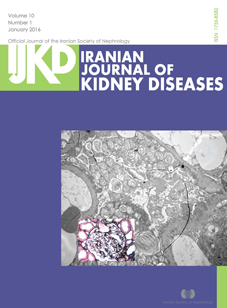Correlation Between Aortic Root Elastic Properties and Glomerular Filtration Rate in Patients With Chronic Kidney Disease
Abstract
Introduction. Aortic root stiffness is a highly prevalent condition in patients with chronic kidney disease (CKD), which independently associates with increased risk of mortality and morbidity in this group. This study aimed to investigate the relationship between glomerular filtration rate (GFR) level as a marker of kidney function and elastic properties of aortic root obtained with echocardiography.
Methods and Materials. Eighty-two patients (53 men and 29 women; mean age, 57.9 ± 15.0 years) with CKD stages 3 and 4 were enrolled in this study. Echocardiography and tissue Doppler imaging of the upper and lower aortic walls were done. Systolic wave (S wave) was obtained from each walls. Aortic distensibility and aortic root stiffness index were calculated using blood pressure measurement and aortic dimensions in systole and diastole by M-mode echocardiography.
Results. In all of the patients, aortic stiffness index (14.24 ± 9.82), aortic distensibility (0.018 ± 0.015), aortic upper wall S velocity (0.10 ± 0.03), and aortic lower wall S velocity (0.08 ± 0.02) were severely impaired. There was no correlation between GFR and aortic distensibility (r = -0.253, P = .20), aortic root stiffness index (r = 0.193, P = .09), aortic upper wall S velocity (r = -0.106, P = .17), and aortic lower wall S velocity (r = -0.150, P = .09).
Conclusions. Aortic stiffness was seen in all patients with kidney failure in stage 3 or 4 of CKD; however, we could not find any direct relationship between GFR and this phenomenon. Thus, aortic root stiffness may be a consequence of hypertension and other risk factors.


